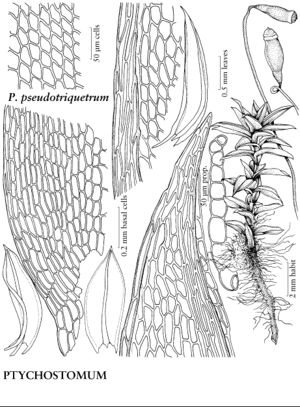Ptychostomum pseudotriquetrum
J. Bryol. 29: 120. 2007.
Plants in dense turfs, green, red-green, or yellow-green, older shoots becoming red-brown. Stems 2–4(–6) cm, tufted, weakly comose to evenly foliate, innovations elongate and evenly foliate; usually strongly radiculose well toward stem apices. Leaves green, red-green, or yellow-green, dull brown-red or brick red with age, somewhat twisted to contorted when dry, ovate, flat to weakly concave, (1–)2–3(–4) mm, not much enlarged toward stem apex; base strongly and narrowly decurrent; margins revolute to mid leaf or beyond, limbidium strong, in 2 or 3 rows; apex acute; costa short-excurrent, awn smooth; proximal laminal cells short-rectangular, 3:1, same width or somewhat wider than more distal cells; medial and distal cells rhomboidal, 14–22 µm wide, (2–)3:1, walls firm to often incrassate. Specialized asexual reproduction occasional, by leaf axil gemmae, brown. Sexual condition dioicous. Seta 1–3(–4) cm. Capsule brown, elongate-ovate, symmetric, 3–5 mm, mouth yellow; operculum conic, apiculate; peristome well developed; exostome teeth yellow basally, hyaline distally, lamellae usually straight mid tooth, pores absent along mid line; endostome not adherent to exostome, basal membrane high, 1/2 exostome height, segments with ovate perforations, cilia long, appendiculate. Spores 12–18 µm, finely papillose, pale yellow or green.
Phenology: Capsules mature Apr–Oct.
Habitat: Wet soil, soil over rock, rock, fens
Elevation: low to high elevations (0-4000 m)
Distribution

Greenland, Alta., B.C., Man., Nfld. and Labr., N.W.T., N.S., Nunavut, Ont., P.E.I., Que., Sask., Yukon, Alaska, Ariz., Ark., Calif., Colo., Conn., Del., D.C., Ga., Idaho, Ill., Ind., Iowa, Kans., Ky., Maine, Md., Mass., Mich., Minn., Mo., Mont., Nebr., Nev., N.H., N.J., N.C., N.Dak., Ohio, Okla., Oreg., Pa., R.I., S.Dak., Tenn., Tex., Utah, Vt., Va., Wash., W.Va., Wis., Wyo., South America, Eurasia, Africa, Pacific Islands (New Zealand), Australia.
Discussion
Ptychostomum pseudotriquetrum is one of the most common and widespread species of Bryaceae, absent only from the subtropics, tropics, and central Pacific Islands. Ovate decurrent leaves, short, stout awn, dense areolation, dioicous sexual condition, and long radiculose stems are characteristic. Ptychostomum bimum is smaller, with much weaker decurrencies, and is synoicous.
Selected References
None.
